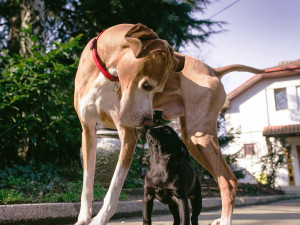The Key to Training Two Puppies at Once
Double the trouble or double the fun?

share article

Your pet wants you to read our newsletter. (Then give them a treat.)
It’s totally tempting to get two puppies at once (in dreams, we imagine having even more, TBH, even though it’s generally unwise to get more than one, and it’s especially problematic to get littermatesopens in a new tab.) But as adorable as it sounds, two puppies at the same time is A LOT of work. Take heart, though: the problems you may encounter — feeling overwhelmed by double the training, for example — are common in households with two puppies, and you can definitely make the situation better.
The most important step is to spend time alone with each puppy daily. Besides helping you build a strong relationship with each of the dogs, this will also accustom them to being separated. Use this one-on-one time to work on training. The pups need to be trained individually before you try to work with them as a pair, because they are going to distract one another when they’re together.
The time you spend alone with each puppy shouldn’t be all work — engage them in other activities as well. Playing, going on walksopens in a new tab, or taking a class together are all ways you can spend valuable time with each dog. Another benefit is that you can focus on doing what that dog enjoys most. Perhaps one loves nothing more than to have you practice canine massageopens in a new tab on him, while the other pup’s favorite activity is running and jumping in the wateropens in a new tab.
It is wise to let them be individuals; living in the same house does not mean that they necessarily have identical personalities or that they have the same needs. On the flip side, the fact that one dog dislikes riding in the car doesn’t mean that it isn’t fun for the other dog. No matter how similar they are, treat them as individuals. The more you do, the more likely it is that they will have a strong bond with you, and the easier it will be for you to get their attention.
Recommended Reading
Feeling Outnumbered? How to Manage and Enjoy Your Multi-Dog Householdopens in a new tab by Karen B. London and Patricia B. McConnell.
Raising Puppies & Kids Together: A Guide for Parentsopens in a new tab by Pia Silvani and Lynn Eckhardt.

Karen B. London, PhD, CAAB, CPDT-KA
Karen B. London, Ph.D., is a Certified Applied Animal Behaviorist and Certified Professional Dog Trainer who specializes in working with dogs with serious behavioral issues, including aggression, and has also trained other animals including cats, birds, snakes, and insects. She writes the animal column for the Arizona Daily Sun and is an Adjunct Professor in the Department of Biological Sciences at Northern Arizona University. She is the author of six books about training and behavior, including her most recent, Treat Everyone Like a Dog: How a Dog Trainer’s World View Can Improve Your Lifeopens in a new tab.
